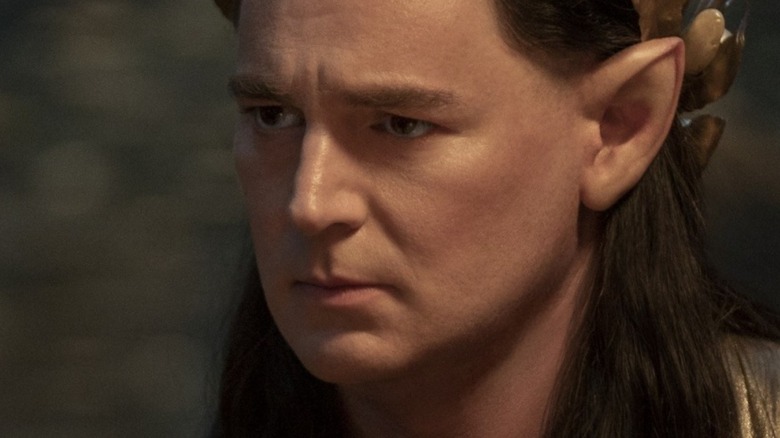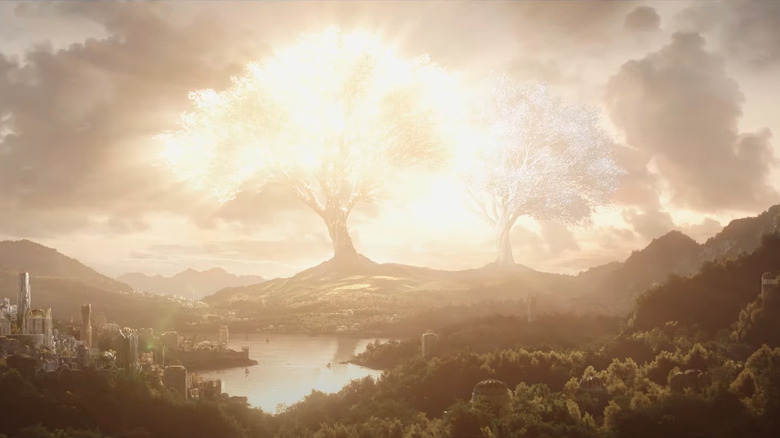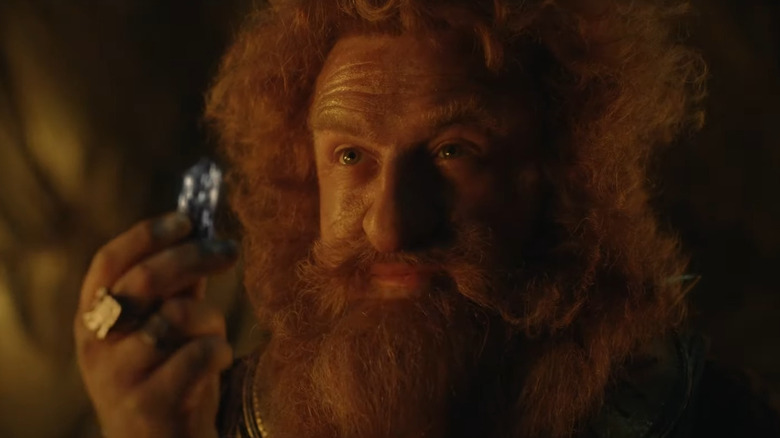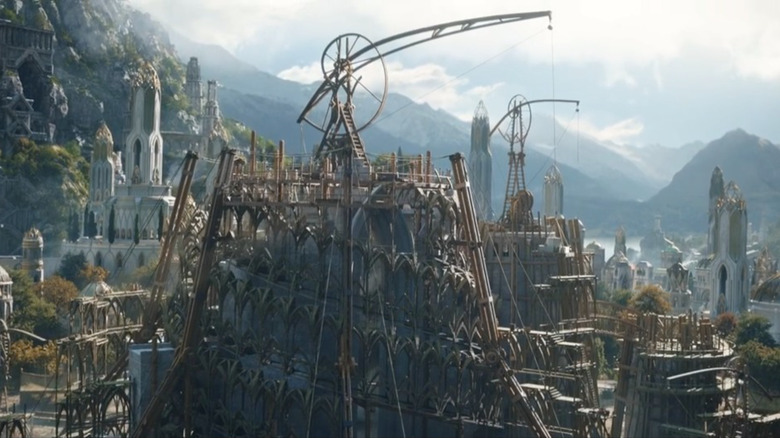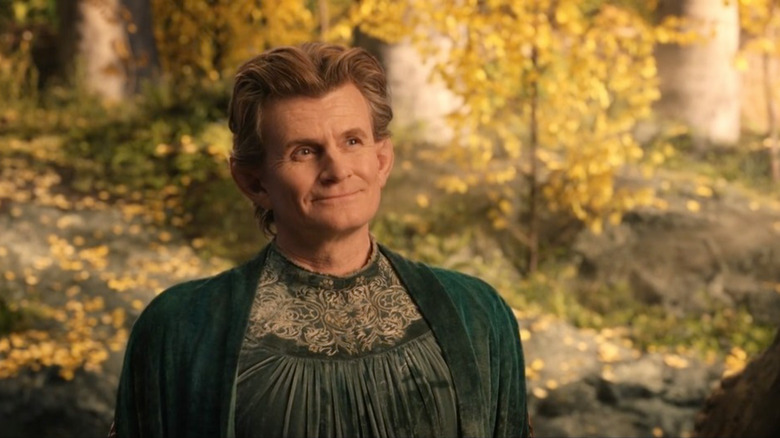The Connection Between Mithril And The Silmarils On The Rings Of Power Explained
Contains spoilers for "The Lord of the Rings: The Rings of Power" Season 1, Episode 5 — "Partings"
Episode 5 of "The Lord of the Rings: The Rings of Power" finally returns to the Elven realm of Lindon after a three-episode hiatus. The event that brings the story back to the golden, forested haven is a meeting between the High King Gil-galad (Benjamin Walker) and Prince Durin IV (Owain Arthur) of Khazad-dûm. The Half-elven Herald Elrond (Robert Aramayo) is present, as is Lord Celebrimbor (Charles Edwards), leader of Eregion. As the conversation unfolds (both during and after dinner), a lot of mysterious details are finally clarified regarding Gil-galad and Celebrimbor's odd behavior in the series up to this point.
Both Elves have been (both directly and indirectly) pushing Elrond to enter Durin's secretive home and see what he can see. On the surface, this seems to be connected to Celebrimbor's unspecified need to build a massive tower with a powerful furnace. During the episode, though, it finally comes out that the motivation behind this move is to find a crap ton of mithril, heat it up, and use it to bathe every single Elf in the light of the Valar once more.
The revelation comes from an obscure legend that Elrond recounts of an Elf and a Balrog competing over a tree containing one of the Silmarils. The event leads to a lightning strike that turns the roots of the tree into light-infused mithril — a single vein of which runs down into the mountain. The story is a bit odd, as is the need for the Elves to literally soak in the light of the Valar to avoid fading. The question is: Is there any context for this concept in J. R. R. Tolkien's source material? The answer is a resounding "kind of."
A brief history of the Silmarils
Let's start with an impossibly brief summary of the Silmarils. These are three hallowed gems that are created very early on in Middle-earth history by the famous Elven leader and master craftsman Fëanor. The gems themselves are one-of-a-kind marvels that literally contain the light of the Two Trees of Valinor that lit the world before the Sun and Moon (both of which are also made from their light after the arboreal wonders are destroyed).
The gems are so incredible that the original Dark Lord Morgoth steals them, leading to a mass exodus of a group of Elves called the Noldor (partially led by Fëanor himself). They chase the villain back to Middle-earth, where they try to take back the jewels by force. This leads to the events that form the bulk of "The Silmarillion" — and yes, that book is named after the jewels, too.
Ultimately, one of the Silmarils is given to Elrond's dad, Eärendil, who becomes a star and sails the heavens with the jewel strapped to his forehead. The other two suffer more mysterious and depressing fates. One ends up in the ocean, and the other is thrown into a fiery pit. This leads to a nice, tidy finale with the three most important jewels in Middle-earth history coming to rest in the air, earth, and water.
What's that? None of the Silmarils ended up in a tree on a mountain top? Yeah. Let's keep moving.
A crash course on mithril
Elrond describes mithril perfectly when, in Episode 4 of "The Rings of Power," he refers to it as a "miracle ore." In "The Fellowship of the Ring," Gandalf describes the amazing metal thusly, "It could be beaten like copper, and polished like glass; and the Dwarves could make of it a metal, light and yet harder than tempered steel. Its beauty was like to that of common silver, but the beauty of mithril did not tarnish or grow dim."
There's a possibility that mithril exists on Númenor as well as in the Blessed Realm away in the West. But eventually, both of these areas become inaccessible to Middle-earth inhabitants, leaving just one other place where the precious substance can be mined: Moria. In fact, one of the other names for mithril is Moria-silver.
At some point, probably in the Second Age, the Dwarves of Khazad-dûm discover a single vein of mithril running into the mountains north of their kingdom. They exploit the mine and become fabulously rich in the ensuing millennia ... until they dig so greedily and so deep that they disturb a Balrog. The fiery demon routs them from their home, cutting off the world's only mithril deposit in the process.
Mithril becomes even more important once it's no longer mined, but did you notice, once again, that there's a conspicuously absent part of the story? A part that should have to do with a tree and a Silmaril and a mountain, or some such legendary vaguery? Yeah.
Bringing mithril and the Silmarils together in The Rings of Power
Now we come to it. When you bring all of this together, one fact becomes clear: mithril and the Silmarils never cross paths in J. R. R. Tolkien's original writings. The precious metal is just that, precious, but it doesn't come from an apocryphal fight with a Balrog that fuses goodness and evil into a light-infused substance.
The Silmarils suffer from unknown fates, and it's true that Tolkien doesn't clarify what happens to them after they disappear at the end of the First Age. We know they still exist and that one of them is in the sky, but that's it. Still, unless there's an obscure note in Tolkien's writings somewhere, from where we're standing, the idea that they're connected to mithril appears to be completely made up for Amazon Prime's story.
And yet, there's an interesting shred of truth in the tale, and it has to do with Elves fading. Elvish immortality is an interesting concept. In fact, the Eldar aren't immortal, strictly speaking. Their perpetual nature is more like serial longevity that is connected to the existence of Arda (that is, the physical world). Over time, the Elves do fade in some generally undefined capacity.
This concept of "fading" is referred to throughout Tolkien's writings. Galadriel talks about it in "The Fellowship of the Ring" when she explains that if the Rings of Power are removed from the equation, "then our power is diminished, and Lothlorien will fade, and the tides of Time will sweep it away. We must depart into the West, or dwindle to a rustic folk of dell and cave, slowly to forget and to be forgotten." Throughout Middle-earth's history, the Elves are aware of this fading process and what it means for them in the end.
Preserving what still is
A lot of the fear of fading surrounding the Elves is connected to a disconnect from the West. Elves who have seen the Two Trees are consistently described in J. R. R. Tolkien's writings as having an extra level of wisdom and clarity that their Middle-earth brethren lack. And yet, what this fading looks like is never made clear. There's even a page for the "Light of Valinor" on the impeccably researched online Tolkien encyclopedia Tolkien Gateway that talks about the impact that the light of the Blessed Realm has on the Elven folk. And yet, even that description is marked as needing sources (of which it has precisely zero to back it up at the time of this writing).
With that said, there is plenty of evidence of the Elves looking for ways to stem the decay of time. The easiest example comes from Elrond in "The Fellowship of the Ring," when he describes the utility of the Three Elven Rings by saying, "Those who made them did not desire strength or domination or hoarded wealth, but understanding, making, and healing, to preserve all things unstained."
The takeaway here? A connection between mithril and the Silmarils is something that exclusively belongs to "The Rings of Power." However, it highlights a very Tolkienian fear of fading that the Elves eventually try to address in the source material ... primarily with the Three Elven Rings. Could it be that the attempt to use mithril to stem Elven fading is merely a setup to create the desperate circumstances in which they're willing to resort to forging Rings of Power to save their decaying state? Only time will tell.
